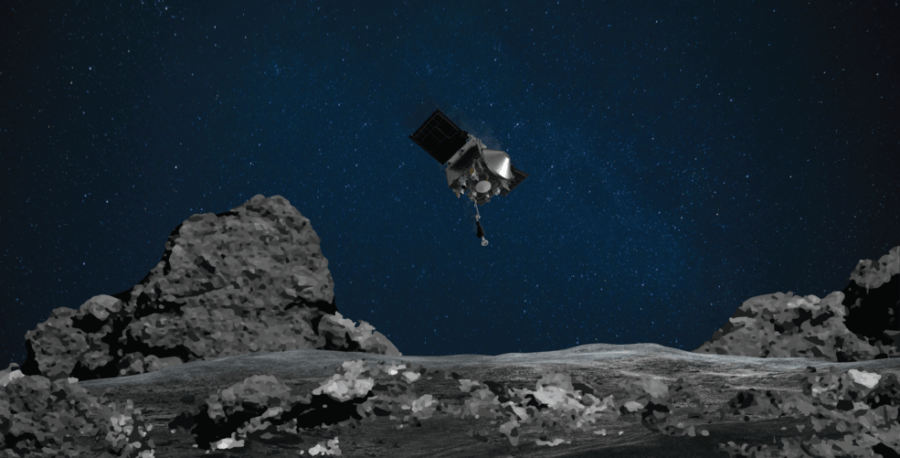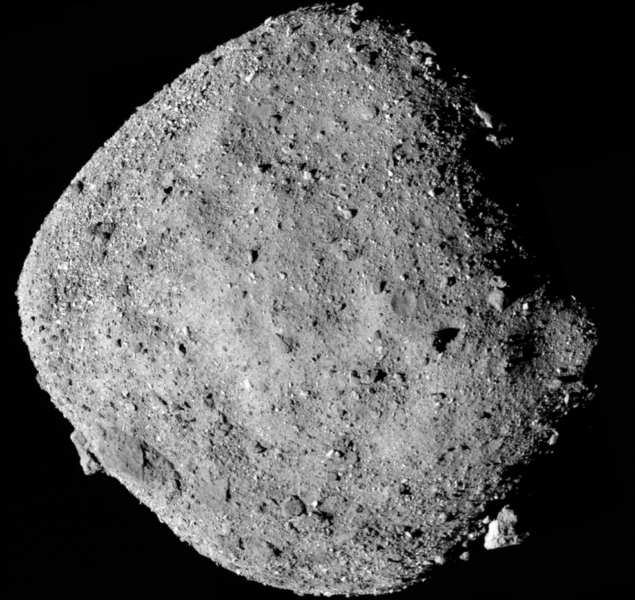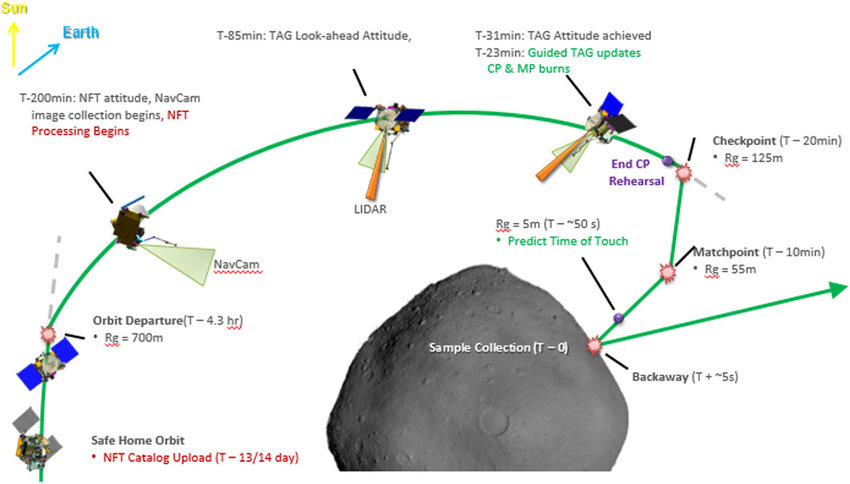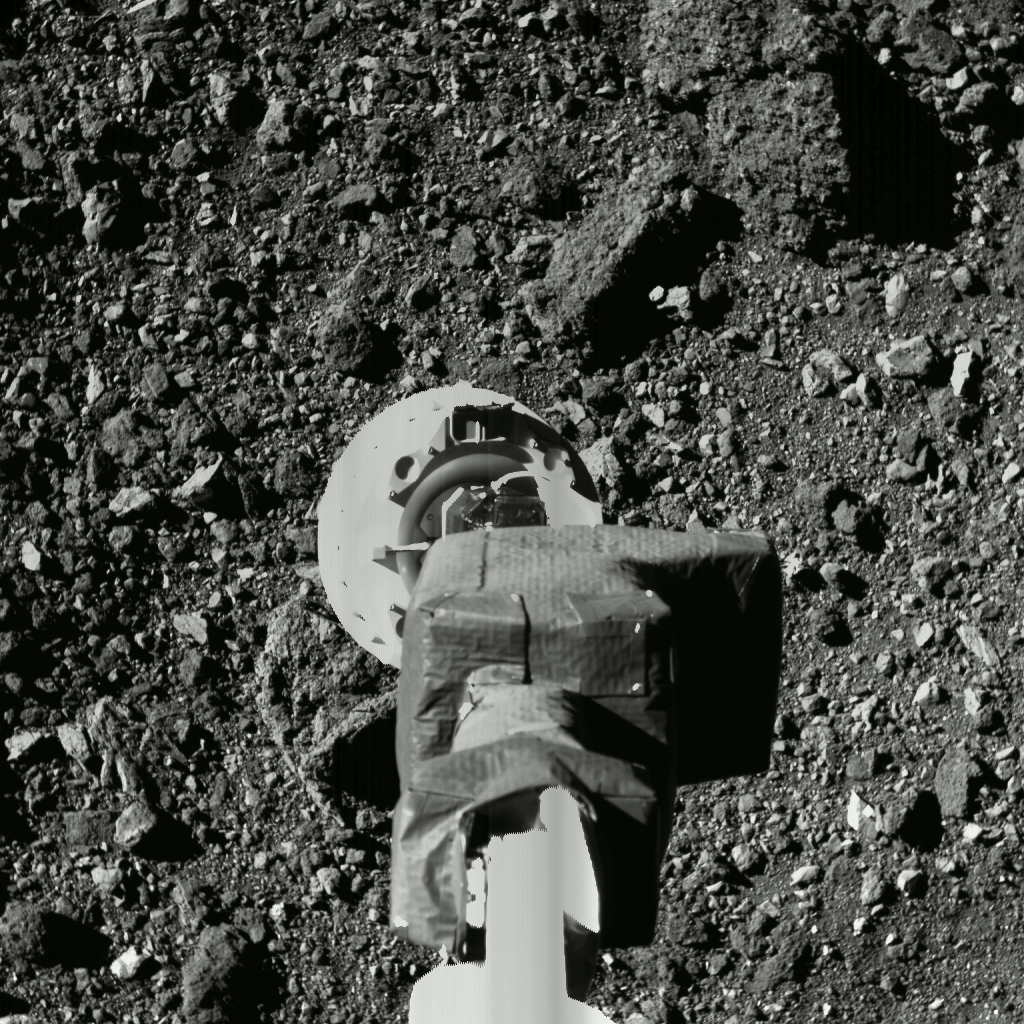
NASA/Goddard/University of Arizona
It’s been a long time coming, but if all goes as planned, NASA’s Osiris-REX spacecraft will reach out and touch asteroid 101955 Bennu tomorrow, in order to collect a sample to return to Earth. The mission’s approach and sampling activities will be broadcast live on NASA TV and the agency’s website starting at 5 p.m. EDT (actual touchdown is scheduled for 6:12 p.m. EDT).
Launched atop an Atlas 5 rocket from the Cape Canaveral Air Force Station on September 8, 2016, Osiris-REX carried out an Earth flyby on September 22, 2017, and arrived at Bennu on December 3, 2018. The spacecraft now keeps pace with Bennu on its 437-day orbit around the Sun, completing loops around the asteroid between 22 and 62 hours long.

NASA / Goddard / University of Arizona
Upon arrival, researchers realized that they would have to carefully consider their approach to the boulder-strewn asteroid. Half a kilometer across, Bennu spins on its axis once every 4.3 hours, and its jumbled terrain features boulders bigger than Osiris-REX itself. The surface was much bumpier than researchers had expected from Earthbound observations, so they took time (and many additional observations) to work out how to proceed. The mission team mapped Bennu at a resolution down to 5 cm (2 inches) per pixel in preparation for this week’s sampling.
Researchers hope that samples brought back from Bennu will give us pristine examples of conditions in the primordial solar system. If the first sampling maneuver doesn’t go as planned, there are two possibilities for back-up attempts.

NASA / GSFC
“If all goes well, the Touch-and-Go Sample Acquisition Mechanism (TAGSAM) will stow the gathered material and begin the trip home,” says mission project manager Roger Harris (OSIRIS-Rex Project Manager) in a recent press release.
The touch-and-go maneuver isn’t so much a landing as it is a brief “hand slap” of the asteroid’s rocky surface. Bennu is currently 18 light-minutes away (more than twice the average distance between Earth and the Sun), so the spacecraft is on its own as it carries out the sampling attempt. The spacecraft will use its Natural Feature Tracking System for terrain avoidance on approach and departure, and a five-second timer will limit the collection sequence to avoid spacecraft collision with the surface.

NASA / Goddard / University of Arizona.
Sequence of Sampling Events
Starting at 1:50 p.m. EDT / 17:50 UT, Osiris-REX will begin to match the rotation of the asteroid and approach the 16-meter-wide Nightingale region. The spacecraft will be in a Y-configuration with its solar panels upraised to avoid any run-ins with boulders. The sampling itself will occur at 6:12 p.m. EDT / 22:12 UT. This maneuver isn’t unpracticed: Osiris-REX carried out a dress rehearsal over Nightingale on April 15th.
NASA TV will carry the TAG live starting at 5:00 p.m. EDT / 21:00 UT. During the maneuver, the TAGSAM arm will extend to place a collection dish the size of a dinner plate on the asteroid’s surface. It will fire a burst of nitrogen gas to stir up material into the sampling compartment. Then, the spacecraft will fire its thrusters and back off to a safe distance.
NASA / Goddard / CI Lab
After retreating, a close-range camera known as SAMCAM will image the sampling mechanism. Then, since it’s not possible to place a sample on a scale i n space, the spacecraft itself will spin to weigh what it has collected. The mission is looking to gather at least 60 grams (2 oz) of material, about the mass of a C-battery. The next samplings, if required, will occur later this year.
NASA / Goddard / CI Lab
Once verification is complete, the arm will fold in to stow the sample onboard:
NASA / Goddard / CI Lab
The Long Return Home
Osiris-REX is scheduled to depart Bennu on March 3, 2021. The spacecraft will bring its samples back to Earth, ejecting the sample return container during an Earth flyby on September 24, 2023. The capsule will reenter over the Utah Test and Training Range for recovery.
Like the Apollo lunar samples, material from Bennu will be available for researchers to analyze for decades to come. Once back on Earth, it will be NASA’s largest sample return from another world since the Apollo era.
Diamond-shape Bennu resembles another recently explored asteroid: 162173 Ryugu, visited by Japan’s Hayabusa 2. That mission is now en route to Earth with its own sample, which it will deliver in December this year.
Meanwhile, be sure to watch as NASA’s OSIRIS-Rex mission makes history!